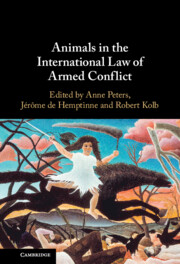Book contents
- Animals in the International Law of Armed Conflict
- Animals in the International Law of Armed Conflict
- Copyright page
- Contents
- Contributors
- Forewords
- Acknowledgements
- Abbreviations
- Part I The Need for Protecting Animals in Wartime
- Part II The Protection of Animals in International and Non-international Armed Conflicts
- Part III The Protection of Animals in Specific Situations
- 13 Animals in Occupied Territory
- 14 Animals in Protected Zones
- 15 Animals in Sea Warfare
- 16 Animals in Disaster Situations
- 17 Animals as Means of Military Experimentation
- Part IV Enforcement Regimes for the Protection of Animals in Wartime
- Part V Towards Better Protection of Animals in Wartime
- Index
- References
15 - Animals in Sea Warfare
from Part III - The Protection of Animals in Specific Situations
Published online by Cambridge University Press: 06 October 2022
- Animals in the International Law of Armed Conflict
- Animals in the International Law of Armed Conflict
- Copyright page
- Contents
- Contributors
- Forewords
- Acknowledgements
- Abbreviations
- Part I The Need for Protecting Animals in Wartime
- Part II The Protection of Animals in International and Non-international Armed Conflicts
- Part III The Protection of Animals in Specific Situations
- 13 Animals in Occupied Territory
- 14 Animals in Protected Zones
- 15 Animals in Sea Warfare
- 16 Animals in Disaster Situations
- 17 Animals as Means of Military Experimentation
- Part IV Enforcement Regimes for the Protection of Animals in Wartime
- Part V Towards Better Protection of Animals in Wartime
- Index
- References
Summary
This chapter analyses the treatment of animals in sea warfare under extant international law and it assesses the adequacy of these norms for the protection of animal welfare. The welfare of marine animals is threatened by warfare in various ways. Individual marine mammals, such as dolphins or sea lions, are trained to take part in hostilities. Other sea life suffers, whether directly or indirectly, the repercussions of hostilities. In the context of prize law, animals could in some cases qualify as contraband goods, susceptible to seizure when on board neutral vessels heading toward enemy ports. It is concluded that the law as it stands today provides neither optimal protection for animals considered as a constitutive part of the marine environment nor for animals in themselves considered as sentient beings. The chapter formulates recommendations for the progressive development of the law, including the creation of a sui generis status for sentient animals, the regulation of military sonars and the establishment of protected marine zones where no combat activities whatsoever should take place.
Keywords
- Type
- Chapter
- Information
- Animals in the International Law of Armed Conflict , pp. 264 - 277Publisher: Cambridge University PressPrint publication year: 2022

